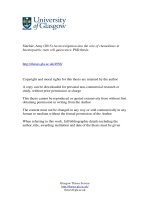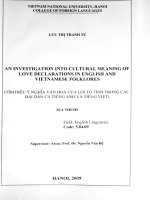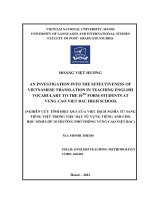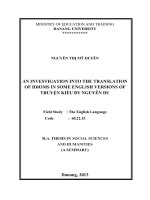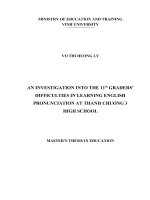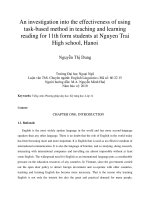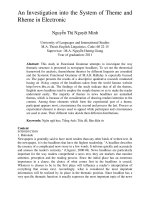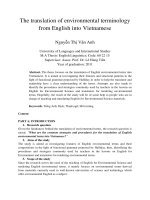An investigation into the translation of advertisement slogans from english to vietnamese
Bạn đang xem bản rút gọn của tài liệu. Xem và tải ngay bản đầy đủ của tài liệu tại đây (713.32 KB, 44 trang )
HANOI OPEN UNIVERSITY
FACULTY OF ENGLISH
_______________________________
GRADUATION THESIS
B.A DEGREE IN ENGLISH STUDIES
AN INVESTIGATION INTO THE TRANSLATION
OF ADVERTISEMENT SLOGANS
FROM ENGLISH TO VIETNAMESE
Supervisor
: M.A. Nguyen Thi Thu Huong
Student
: Luu Trang Linh
Date of birth : 27/02/1994
Course
: K19 (2012-2016)
HANOI, 2016
1
ACKNOWLEDGEMENT
This thesis owes its existence to the help, support and inspiration of
several people. Firstly, I would like to express my sincere appreciation and
gratitude to M.A Nguyen Thi Thu Huong for her guidance during my search. Her
support and inspiring suggestions have been precious for the development of this
thesis content.
I also would to express my special thanks to all teachers of Faculty of
English, who have provided my with not only knowledge but also the study
condition during my student life, as well as their useful advice in this graduation
paper.
I would like to acknowledge my thanks to all the authors of the books and
materials listed in the reference part for their ideas that have been reflected and
developed in the study.
Finally yet importantly, I am indebted to my family and friends who were
fundamental in supporting me during these stressful and difficult moments.
Hanoi, 14 April 2016
Luu Trang Linh
2
DECLARATION
Title:
An investigation into the translation
of advertisement slogans from English into Vietnamese
I certify that no part of the above report has been copied or reproduced by me
from any other’s word without acknowledgement and that the report is originally
written by me under strict guidance of my supervisor.
Hanoi, 14 April 2016
Student
Signature
Supervisor
Signature
3
TABLE OF CONTENTS
Part A: Introduction................................................................................................ 7
1. Rationale .................................................................................................... 7
2. Aims of the study ........................................................................................ 8
3. Scope of the study ....................................................................................... 8
4. Research questions .................................................................................... 8
5. Methods of the study .................................................................................. 8
6. Design of the study .................................................................................... 8
Part B: Development .............................................................................................. 9
Chapter 1: Literature review ............................................................................... 9
1.1. A REVIEW OF PREVIOUS STUDIES .................................................. 9
1.2. THEORETICAL BACKGROUND....................................................... 10
1.2.1. Definition of advertisement and slogan ........................................... 10
1.2.2. The function and features of slogan. ................................................ 13
1.3. SUMMARY ............................................................................................. 15
Chapter 2: Finding, Interpretations and analyses ................................................ 15
2.1. GRAMMATICAL FEATURES ................................................................. 15
2.1.1. Sentential level ................................................................................. 15
a. Reported Speech .................................................................................. 16
4
b. Question ............................................................................................... 16
c. Negative Sentences .............................................................................. 17
d. Imperative sentence ............................................................................. 17
2.1.2. Phrasal level ...................................................................................... 17
a. Noun phrases ...................................................................................... 18
b. Verb phrases ...................................................................................... 19
c. Adjective phrases .............................................................................. 20
d. Adverb Phrase ................................................................................... 21
e. Prepositional Phrase ............................................................................ 21
2.1.3. Tense ................................................................................................. 22
a. Present tense ........................................................................................ 22
b. Future tense.......................................................................................... 22
2.2. STYLISTIC DEVICES ............................................................................. 23
2.2.1. Metaphor.......................................................................................... 23
2.2.2. Metonymy.......................................................................................... 24
2.2.3. Simile............................................................................................... 25
2.2.4. Pun .................................................................................................. 26
2.2.5. Personification ................................................................................ 27
2.2.6. Apostrophe ...................................................................................... 29
2.2.7. Repetition ......................................................................................... 29
2.2.8. Parallelism ...................................................................................... 30
5
2.2.9. Antithesis ........................................................................................ 31
2.2.10. Hyperbole ...................................................................................... 32
2.3. SOUND TECHNIQUES......................................................................... 32
2.3.1. Rhyme ............................................................................................. 32
2.3.2. Alliteration ...................................................................................... 33
2.3.3. Assonance ....................................................................................... 34
2.3.4. Consonance ...................................................................................... 35
2.3.5. Onomatopoeia ................................................................................. 35
2.3.6. Rhythm ........................................................................................... 36
Chapter 3 Discussion ....................................................................................... 37
3.1. Understanding culture in slogan translation ........................................... 37
3.2. Some tips to translate the slogan ........................................................... 39
Part C: Conclusion and recommendation .............................................................. 41
4.1. Conclusion ............................................................................................... 41
4.1.1. Summary of the findings ................................................................... 41
4.1.2. Limitations of the study .................................................................... 42
4.2. Suggestions for further study ................................................................... 42
Reference .............................................................................................................. 43
6
CONTENT
Part A: Introduction
1. Rationale
Today, advertising is an important form of communication that contributes
to the development of the economy. The use of stylistic devices in
advertisements aims at arousing and persuading consumers to buy what is
advertised. The methods and means of advertising are very diverse, but forms of
advertising using language are common forms. However, writer not only is
interested in the choice of words, but also needs to focus on the use of these
measures in his rhetorical art of advertising
The slogan is an important means of promoting products and corporate
branding. The advertising slogan often contains a word or phrase with catchy
content. It used to attract the attention of consumers or express an easy idea to
grasp. Moreover, it also represents all purposes and visions of the business.
However, in the process of translation from English to Vietnamese, translators
often have difficulty in conveying meaning in a brief and comprehensive because
of differences in language and culture.
Therefore, I would like to choose “An investigation into the translation
of advertisement slogan from English into Vietnamese” as a topic of my
graduation thesis. This study will research and analyse the respects which affect
the translation of advertisement slogan from English into Vietnamese.
7
2. Aims of the study
The study focuses on a number of issues:
-
Identifying and describing the characteristics of the language used
in advertisement slogans.
-
Pointing out the factors to influence the translation of advertisement
slogan from English into Vietnamese
-
Making suggestions for the translation of advertisement slogans
from English into Vietnamese
3. Scope of the study
The English slogans were taken from many different sources of product
advertisements, such as technology, pharmaceuticals, cosmetics, etc.
4. Research questions
-
What are the language’s features of advertisement slogan?
-
What are the factors which affect the translation of advertisement
slogan from English into Vietnamese
-
What are suggestion for the translation of advertisement slogan
from English into Vietnamese
5. Methods of the study
-
Consulting the theory on advertisement and slogan
-
Collecting and aggregating slogans in English in product
advertisements.
-
Analysing features of the slogans in English
6. Design of the study
8
The study consists of 3 chapters
Chapter 1 reviews of literature, presents a review of prior studies and
concepts related to the problem under study. General views of advertising and
some fundamental theoretical background to the study will also be presented.
Chapter 2 fully describes the aim and the objective, research design,
research method and procedure, description of population and sample, data
collection and data analysis. This chapter deals with findings and discussion. It
provides the findings of linguistic features of the advertisement slogan.
Chapter 3 gives the conclusions, the reality of the thesis, suggestions for
using stylistic devices the limitations and some suggestions for further research.
Part B: Development
Chapter 1: Literature review
1.1.
A REVIEW OF PREVIOUS STUDIES
In his book “Investigating English Style”, David Crystal and Davy Derek
(1969) emphasized how to use rhetorical measures and the grammatical structure
in the advertising slogan. Geoffrey N. Leech wrote in his book “English in
advertising” the slogan is a short phrase used by the company in its
advertisements to reinforce the identity of the brand "; therefore, how to use the
language of advertising slogans is very important.
In the book he published in 1971, "Stylistics", I. R. Galperin confirmed
9
that in the advert slogan, stylistic devices plays a key role in attracting readers
and listeners.
In "Mastering Advanced English Language" (1997), which was wrote by
Sara Thorne, the language aspect and style of the advertising were analyzed from
many different angles. At the same time, this book reflected the diversity of
languages.
In the article “The Importance of Ad Slogans” , Kristen Hamlin defines
the advertising slogans as “catchy, declarative phrases that use devices such as
metaphors, alliteration or rhymes with simple, vibrant language” (Hamlin 2014).
Even without mentioning the company‘s name or product, the advertising
slogans help people remember the brand.
In Vietnamese, when analyzing the feature of the advertising slogan and
the effect of language in advertising, Tran Dinh Vinh and Nguyen Duc Ton
wrote the book “Về đặc điểm của ngôn ngữ quảng cáo” published in 2004.
“Quảng cáo và ngôn ngữ quảng cáo” (2004) by Nguyen Kien Truong
analyzed the devices which used in the advertising language to increase the
attractiveness of the product.
In “Ngôn ngữ quảng cáo dưới ánh sáng của lí thuyết giao tiếp”, Dr. Mai
Xuan Huy gives an overview about the language of advertising slogans.
1.2. THEORETICAL BACKGROUND
1.2.1.
Definition of advertisement and slogan
Advertising branch is unique in the many aspects. It is supposed to target
as many people as possible. It can be old people, teenagers, children, men or
women. To meet the objectives it is necessary to choose right language, words,
10
the pun in order to attract the customers. This fact means that advertising
branch intervenes into many other fields such as psychology, lexicology,
morphology, gender studies and last but not least cultural studies.
The American Marketing Association has adopted the following as a
definition of advertising "Any paid form of non-personal presentation and
promotion of ideas, goods or services by an identified sponsor." As advertising is
paid for, it is a commercial transaction. It is non-personal, which means that
advertising messages are directed at a mass audience and not directly at
individuals.
According to the American Advertising Association "advertising is
information dissemination activities, stating the intentions of all advertising,
dissemination of goods and services of all advertising on the basis of an ad for a
fee, not directly to attack others"
Each culture is exceptional and inimitable. This is the reason why
advertising is so complex and interesting. The advertisements in spite of this
controversy have become part of our life. However, many people keep fighting
with the advertising industry. The reason might be the obvious aim of ads that
is in many regards so commercial and superficial – to earn money.
The concept of “khẩu hiệu” (Vietnamese) or "the slogan" (English) exists
in many languages and cultures in the world. It is possible to understand this
concept in many forms and semantic aspects, different languages, but first of all ,
let us find out how the dictionary defines the slogan in general.
According to Merriam-Webster Dictionary, the slogan is a variation of the
slogan - derived from Gaelic language of Scotland is sluagh-ghairm (which
11
sluagh as "army / war" are ghairm is "cry". This is a huge cry before the battle of
the warrior Scotland late Middle Ages, with the aim of encouraging and making
military troops enemies fear. The word was first used in 1513. As time passed by,
the word is transformed into sluggorne, slogurn and slughorn. In modern society,
along with the latest concepts "slogan". The dictionary definition is "word,
language attracts attention is used to promote something (be it a campaign or
product)". With such understanding, "slogan" was assimilated to mean "banner"
(ribbons, banners) with features and functionality similar to "banner as the name,
slogan or purpose was tied to a particular group or a particular ideology" . In the
Dictionary Oxford Advanced Learner's Dictionary of Current English , Crowther
has defined that "the slogan is a word or a catchy phrase to attract the attention of
others or suggest an idea quickly" , while in
Collin's Advanced Learner's
English Cobuil Dictionary "slogan is a catchy term short paragraphs, be used in
advertising or by the political parties and other organizations, wants people to
remember what they said or sale" . We can say the definition is inclusive of the
American Heritage Dictionaries Dictionary, where the slogan is defined as "a
phrase / word to express purpose or nature of the agencies, organizations or an
application candidate "; "Is saying used many times during the campaign or
promotion"; "The special words and themes, easy to attract others, are used in
advertising, politics to campaign for a product, or a former contestant somehow.
(Online version, Reference Date 10/06/2013). In studies about the slogan from
the 30s (of the 20th century) until now, a number of authors in the world have
concretized the dictionary definition of contact with reality. According to them,
the slogan was seen as a way of expression designed to enhance the universality
12
of the products and encouragement to buy the products. The slogan is the brief
expression in commercial advertising or promotion of politics is used to express
ideas, principles and purposes of an individual or organization, sometimes just to
let others remember. The slogan played an important supporting role in the
construction of a brand image - a matter of survival of a business. It helps save
the a brand image in consumers’ mind. Concepts were defined as slogans and
illustrations of mandates within the relativity of all political, social, commercial
advertisements and all cultures, military.
1.2.2. The function and features of the slogan.
In commercial advertising, a commercial slogan of a company is considered
as a sentence or short paragraph containing and transmitting descriptive and
compelling information of a brand. Accordingly, the slogan seen as a way to
promote the brand is an extremely effective tool in creating brand value. The
slogan can help customers quickly understand what that brand is and how it
differs from other brands. Slogans can contribute to brand value by increasing
customer awareness of products through a strong impact on their benefits as
consumer products to help save the image of the brand in the minds of customers
to create expectations and promote customer. At the same time, the slogan also
helps a company affirm their commitment to customer service and helps
reinforce the brand through identifying their differences with other companies in
the market. For example, the advertising slogan of the company printing greeting
cards Hallmark's "When you care enough to send the very best".
13
The advertising slogan distinguishes your product or brand from that of
your competitors while also underscoring the company's general mission. If you
have an advantage over your competitors, or if your product or service has a
unique benefit, you need to use it. Slogans are the first impressions for many
potential consumers, so it absolutely needs to stress the company's worth.
Isolating one key area of your business and finding a way to integrate it into the
slogan. Therefore, in the process of translating the slogan, the translator should
understand the main characteristics of the language in the slogans, which may
make an appropriate language.
The slogan is composed of three characteristics: memorable, goal and
interesting.
-
Memorable: An effective slogan should be definitely catchy and
remain in the minds of consumers quickly. Typically, the catchy slogan will have
brief rhyming. For example, Apple's slogan: “Think different" is a success
slogan. People remember the slogans that relate to their lives and have meaning.
-
Goals: One slogan is launched to bring a certain goal and toward
certain objects. A meaningful slogan will certainly evoke emotion and
impression to customers. For example, Nokia slogan "Connecting people". This
slogan has shown success criteria of the company, which is friendly. This slogan
want to show that everyone can connect without any barriers.
-
Interesting: In order to highlight company' slogan than other brands,
this slogan should have fun and express sophistication, individuality, the
difference of the brand. Let us take a slogan for a Muffler company that says
"No appointment necessary. We hear you coming” as an example. We also
14
appreciate the funny, witty slogan or slogan which implies a difference and
creates trust. It can be an emotional slogan to customers as "Very Yomost
feeling" of YoMost.
1.3.
SUMMARY
It can be said that a slogan is like the oath of the business. All purposes,
missions and visions of the business are contained in a brief statement. The
indispensable factor of a slogan is attracting the attention and impressing
everybody. A slogan is a self-referral, self-promotion, a message sent to
identified customers, in the form of fans. At the same time, it has to let
consumers know the characteristics, advantages of the product, the benefits and
satisfaction that it brings to them. And all those contents are only allowed to
include a few short, easy to read and easy to remember words. In other words, a
slogan is a concise form of expression, rich in meaning and strong in impression.
The slogan uses few words, but it conveys many things. Therefore, the words
and images play extremely important role in the slogan.
Chapter 2: Finding, Interpretations and analyses
2.1. GRAMMATICAL FEATURES
2.1.1. Sentential level
In order to be easily understandable, English advertising tends to adopt short
sentence. Besides, short sentences may help to retain readers attention and persuade
them to buy products of the company.
15
a. Reported Speech
The slogan must be short and simple; it should not be complicated and
clumsy. Using a short statement will help customers to remember products.
•
S+V
The Citi never sleeps
(Citibank – 1977)
Drivers wanted
(Volkswagen)
• S+V+C
It's the real thing
(Coca cola - 1969)
Impossible is nothing
(Adidas – 2004)
• S + V + Oi + Od
You've Got a Lot to Live, Pepsi's Got a Lot to Give
(Pepsi)
It gives you wings
(Red Bull)
• S+V+O+A
I'd walk a mile for a Camel.
(Camel – 1921)
b. Question
The questions are often used in the slogan to evoke curiosity from
customers. Using questions also makes the slogan become more interesting.
• Yes – No question
Are you a Cadbury's Fruit & Nut case?
(Cadbury's Fruit & Nut)
Does she or doesn't she?
(Clairol)
• Wh- Question
Where do you want to go today?
(Microsoft)
Which twin has the Toni ?
(Tony)
16
c. Negative Sentences
Use negative sentences in advertising emphasize the contradiction from
which customers will see the advantages of the product.
Sometimes you feel like a nut, sometimes you don't
(Peter Paul Mounds)
You can’t beat the real thing
(Coca Cola)
d. Imperative sentence
In an advertisement slogan, imperative sentence can exhort the potential
customers to act, to buy and to consume.
Just do it
(Nike)
Think different
(Apple)
2.1.2. Phrasal level
Slogans are a kind of special writing form. Characteristics of the slogan are short
and concise so that the phrases are often used a lot in creating a slogan. Therefore,
phrases may be as good as or even better than sentences. The phrase is used very
flexibly.
According to the study of State University of Malang, the researcher found 49
phrases of 42 products from the advertisements taken. The findings of types of
phrases on the advertisement slogans will be classified in the table below.
Table . Types of Phrases
Phrase
Frequency
Verb Phrase
23
Percentage
47%
17
Noun Phrase
19
39%
Adjective Phrase
2
4%
Adverb Phrase
2
4%
Prepositional Phrase
3
6%
Total
49
100%
Table1 shows that the most frequent phrase used in the advertisement slogans is
verb phrases which are occurred 23 times (45%). On the second place, there are noun
phrases which are used 19 times (39%). Prepositional phrases are the third frequent
phrase used in the advertisement slogan. It was found that prepositional phrases were
used 3 times (6%). The least used phrases were adverb phrases and adjective phrases
which were used only two times (4%).
a. Noun phrases
Most copywriters form noun phrases by inserting prepositional phrases
or adjective phrases or both for the determiners. Adjective phrases as the
determiners on noun phrases give effect on glorifying the products. The
copywriters put adjectives to tell the readers the special characteristics of the
products. They want to inform what the distinctive qualities of their products
compared to the others products are.
• Basic noun phrases
-
Possessive + N
Your potential. Our passion
(Microsoft)
18
Your vision. Our future
-
(Olympus)
Article + nouns
The Uncola
(7 UP)
The future's bright. The future's Orange
(Orange)
• Complex noun phrases
-
Adj + N
Right service. Right price
-
Preposition + N
For mash. Get smash
-
(Ford, Australia 1970)
(Smash)
Possessive +Adj + N
Your flexible friend
(Microsoft access)
In general, prepositional phrases put as the determiners to tell the readers
the benefits of the products. The slogans use the words “for” to inform what
advantage the readers will get. In addition, many copywriters combined adjective
phrases and prepositional phrases as determiners in noun phrases to make the
slogan stronger. The slogans are expected to ensure the readers that their
products are the best.
b. Verb phrases
Verb phrase is the most frequently used phrase for advertisement slogans.
In making verb phrases, the advertisers use varying modifiers to modify the
verbs. Carnie stated that a verb phrase can have adverbs, nouns, and also
prepositional phrases as the modifiers. From the data taken, it was found that the
19
copywriters used nouns, adverbs, adjectives, or prepositional phrases as the
modifiers of some verb phrases in slogans.
-
V+O
Share moments. Share life
(Kodax)
Open Happiness
(Coca cola)
In general, verb phrases are used to give promise to the reader. There
are various verbs used by the advertisement writer such as make, get, take, etc.
For example the Coca Cola slogan: Open Happiness. The slogan suggests to
consumers that if they drink it, they will feel comfortable and happy. By giving
promises and orders, verb phrases have strong power to raises readers’ curiosity
and make them want to prove the advertisement. As the result, to confirm the
slogan, the readers will try or buy the products. Due to the advantages of verb
phrases, many copywriters prefer to use verb phrase as the slogan.
c. Adjective phrases
-
Comparison
Stronger than dirt
-
(Ajax)
Adj + prep.Phrase
Bigger in Texas. Better in a Dodge
(Meineke)
In general, adjectives appear inside noun phrases (Carnie, 2006).
Carnie also stated that in grammar, the function of the adjective is to attribute
properties to the item they modify. Moreover, since advertisements are not
always of the correct grammar, copywriters can make adjectives stand without
nouns. In the data, it was found that all the adjective phrases consist of more than
20
one adjectives and one adjective modifying the other adjectives. Adjective
phrases have almost the same function as adverb phrases. Adjective phrases in
advertisement slogan give information of the characteristics of the products. The
readers are expected to know the quality of the products and what make them
special. Furthermore, adjective phrases on slogan only can inform the readers
about the products as the adverb phrases do.
d. Adverb Phrase
Technically, everything is possible
(Mitsubishi)
Always listening. Always understanding
(Prudential)
In general, adverbs are functioned as the modifiers in a sentence or to
give further information about certain conditions. However, it was found that
adverb phrases are not always become the modifiers to the other lexical
categories. In the slogan, adverb phrases can stand alone as the main phrase.
Adverb phrases employed in order to give further explanation about the products.
e. Prepositional Phrase
For a whole mouth clean
(Colgate 360° Toothbrush)
For successful living
(Diesel jeans)
Mostly, prepositional phrases on slogans are aimed to inform the
readers the function or the benefit of the products. Telling the benefit is one of
some selling strategies. Readers can be attracted if they are told what they will
get from the products. However, not many copywriters think that prepositional
21
phrases are strong enough to fascinate the readers. This can be seen from the
findings of prepositional phrases in slogans. There are only three slogans found
which employ prepositional phrases.
2.1.3. Tense
a. Present tense
Consumers are often concerned with nature and current use of the product.
Therefore, many the advertisement slogans exhibit a preference to the present
tense usage. In English, the present tense is used for characterization of habitual
actions, narration of historical present, reporting mental or emotional state,
commenting on immediately accompanying actions and demonstration or
explanation of the individual acts involved. The present tense verbs help English
advertisements slogan to characterize and portray the desirable situation, express
positive thoughts, comments and show the benefits of the advertised object. Also,
the present tense shows that the action is happening now and that everything
being said is a “general truth”.
Where do you want to go today?
(Microsoft)
Heineken refreshes the parts other beers cannot reach
(Heineken)
b. Future tense
The present tense helps to create a more intimate relationship with the
addressee than the future tense do. Therefore, future tense was not commonly
used in the slogan. The future tense is used to characterize and portray a positive
22
picture or to express promises and certainty for a future event. Here is an
example illustrating the occurrence of future verb form.
My wife, I think I’ll keep her
(Geritol)
That'll be the Daewoo
(Daewoo)
2.2. STYLISTIC DEVICES
2.2.1. Metaphor
A metaphor is a figure of speech that identifies something have similar;
thus, the implied conceptual relationship rhetorically highlights the, at times
difficult to conceive, similarities between two ideas. When using a metaphor,
two seemingly unrelated things are compared by stating that one is the same as
the other; this helps to see the similarities or connections which would remain
unrevealed without the metaphor. Leech maintains that metaphors are valuable in
the advertising language as they “suggest the right kind of emotive associations
for the product”
Both of the two slogans analyzed below are from two most famous soft
drink brands - Red Bull and Coca Cola. The first one made its appearance in
1997. The Coca Cola slogan published in 2006.
- Red Bull gives you wings
(Red Bull, 1997)
- The Coke side of life
(Coca Cola, 2006)
23
“Red Bull gives you wings” has been the energy drink's slogan for nearly
two decades. It's obviously a smart advertising slogan. It states that it gives you
wings, but it is really a metaphor. It can be seen from the word wings that the
underlying conceptual metaphor in the slogan of Red Bull. This slogan has a
simpler linguistic expression. It is rather clear that the advertisers want us to
believe that by drinking Red Bull we can have the energy to tackle anything;
hence, the consumption of the beverage will give the consumer physical strength
implying that any task that you attempt will be much easier since you feel like
you have wings. It boosts your confidence to do anything.
Advertising slogan of Coca Cola is also a slogan with metaphor. Life often
reminds people of different aspects such as good or bad, negative or positive, etc.
But in the slogan above, Coke (common names of Coca Cola) becomes a
separate aspect of life. The producers want to use metaphors to emphasize to
consumers that when drinking this drink, customers can feel a fresh life. This
also makes customers more curious about the product.
2.2.2. Metonymy
Cuddon defines metonymy as “a figure of speech in which the name of an
attribute or a thing is substituted for the thing itself ” (Cuddon, 1999). Myers states
that metonymy is commonly found in advertisements “where the products associated
with some person or surroundings” (Myers, 1997).
For example:
Take the gold
(Adidas)
24
Metonymy is rhetorical measures are common in advertising. Metonymy
used here is the word "gold". The word gold implies the gold medal. Referring to
the gold medal, people think of the victory. In this slogan, producers want to take
advantage of the significance of the gold medal to emphasize the quality of the
product in a very natural way. Everyone knows Adidas as a company wellknown for sporting goods, but more than that, they want to emphasize that using
the company's products will enable customers to feel comfortable and achieved
success.
Another example of the use of metonymy in which slogan is the slogan of
the company Volvo.
I like Volvo
(Volvo)
In this slogan, a single word expresses the whole group: ‘I like Volvo’ (=
Volvo cars). Volvo brand name stands for any of the cars produced by Volvo.
The author uses the name to elicit a wide range of products of the company. In
addition, short and catchy slogans are easy to impress customers.
2.2.3. Simile
In order to reinforce the image, advertisers employ a simile, which
presents “a figure of speech in which one thing is likened to another, in such a
way as to clarify and enhance an image. It is an explicit comparison” (Cuddon,
1999). The simile directly compares two things through the explicit that use of
connecting words such as like, as or various verbs such as resemble. Although
similes and metaphor are sometimes considered to be interchangeable, similes
acknowledge the imperfections and limitations of the comparative relationship to
25
